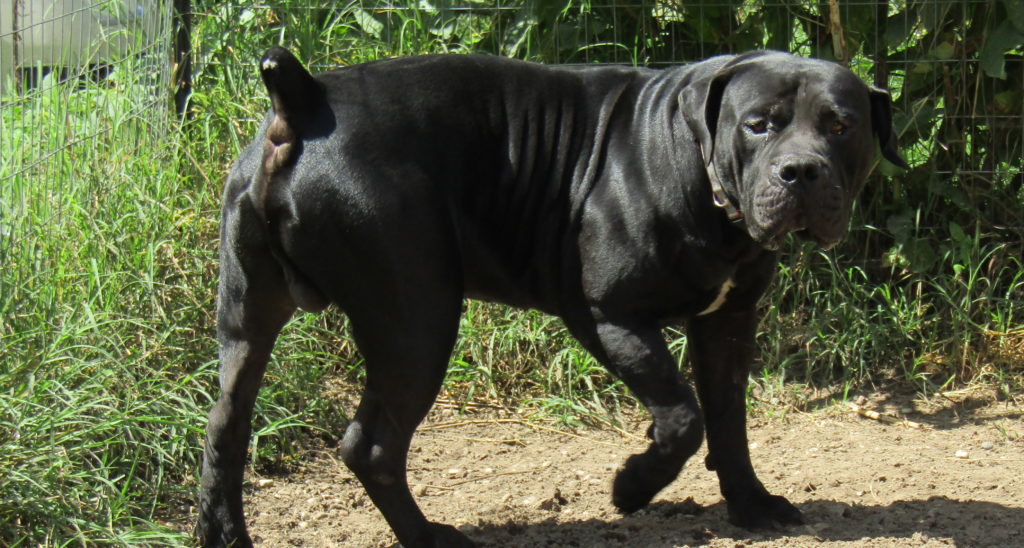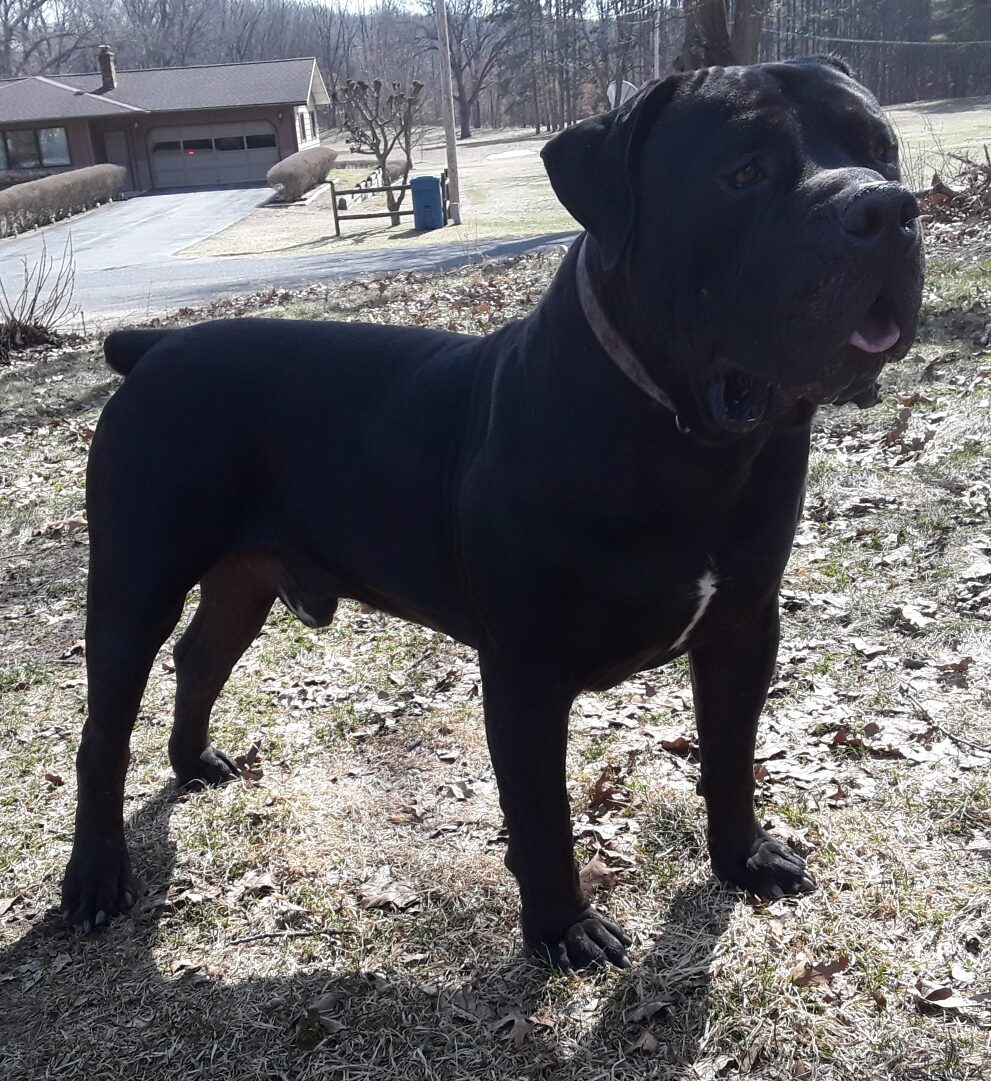
The Boerboel (pronounced similar to male pig (BOAR), male cow (BULL); more correctly, BOORDR-BUHL) is sometimes improperly called the South African mastiff. It’s name in Afrikaans means “farmer’s dog” and tells a humbling tale of this dog’s origin. For centuries, Boer boels have been used to protect farms (family and livestock) from thieves and predators in South Africa. Traditionally, their tails are docked, as this served to protect them from baboon attacks (at least that’s the competing theory), but it is acceptable in show for them to have docked or intact tails. Boerboels are fiercely protective, but exceptionally loyal to their family unit and home territory. They tend to be very tolerant of children and other animals, though male Boerboels are notoriously aggressive towards other male dogs that enter their space. They are affectionately known as “velcro dogs”, because they hate not being at their owner’s side at all times. Boerboels form intense bonds with one or two people and are generally aloof towards others. They bond so deeply with their primary caregiver that they often get jealous of others who occupy that person’s time, therefore it is critical that they be trained properly from a young age to respect others in the home and their place in the pack. The Boerboel copes very well as the only dog in a household, but should also be tolerant of other dogs, especially of the opposite sex. Boerboel males are typically 120-160 lbs. fully-grown, but can reach 200lbs. Bitches are typically 100-140 lbs., but can reach up to 170 lbs. Acceptable coat colors for show are fawn, red, or brindle (preferred colors), but also black [accepted in 2017] and piebald or Irish-marked. The Boerboel was officially established as a breed by SABT in 1983. SABT has since disbanded and the breed does not have an official parent club, nor FCI recognition, though SABBS, in South Africa, currently has the most clout over the breed’s direction. AKC officially recognized the Boerboel as a breed in 2015. Other reputable kennel clubs that register the breed include WBBA, NABBR, UKC, BI, and ABC.
The Boerboel is said to be the most agile and athletic of all the mastiff breeds. They are compact and muscular; extremely powerful, but nimble. A Boerboel is well-suited to a life of work on a farm, but also is content to be a couch potato cuddled up next to his master. They need at least one hour of daily exercise to stay healthy and happy. Boerboels are extremely intelligent, but also stubborn. They maintain a dominant personality, but are extremely eager to please the person who feeds them and gives them the most attention. The Boerboel puppy is much easier to raise and is far less destructive than most large dog breeds. If provided durable toys, they tend to be very respectful about chewing only on the things they are allowed, and respond well to simple corrections. They potty-train and crate-train easier than most dogs. They rarely bark, unless to alert their owner of a potential threat, and their whine, when upset, is very low and tolerable. Boerboels are not very sensitive in the physical sense, but exceptionally sensitive emotionally. A Boerboel should NEVER, EVER be struck for any reason. This can immediately damage a bond between the dog and his owner, and the Boerboel may exhibit signs of distrust and disloyalty. The NILF training method works amazingly for Boerboels ( http://www.sccpets.com/PFL/NothingInLifeIsFree.pdf ) and is my recommended method to train your Boerboel puppy. Most Boerboels do not pose a significant challenge to their owner until after puberty (12-24 months of age), where many exhibit “terrible teenager” behavior; displays of dominance and rebellion where they try to take charge of a meek owner. It is important during this time to be firm and consistent with your training and reinforcement. Do not give in to signs of dominance displayed by your Boerboel and show no fear towards them. When the hormones settle back down to normal adult levels, your Boerboel will return to its former state of love, devotion, and obedience. If you become inconsistent with discipline or fearful of your dog, this breed will become completely unmanageable. If you experience difficulty, hire a professional trainer to help. The last thing you want is an unruly, exceptionally powerful dog with a mind of its own in your home.
Boerboels can be an expensive breed to own. Once one of the healthiest of all Molosser breeds, the current state of the breed is concerning; primarily due to large size selection and premature or lack of health testing by mass breeders. Over half of all Boerboels born since the mid-2010s have either hip or elbow dysplasia, or both. Heart problems, such as SAS and early age cancer are also common in some bloodlines. The breed currently averages about a 7 year lifespan, but smaller dogs from healthy working lines can easily live past age 10. They eat a lot and are prone to seasonal allergies. You may need to administer allergy medication, such as Benadryl, Zyrtec, or Claritin during the allergy season. Consult with your veterinarian for best treatment options. Entropion (eyelid curls in on itself) or ectropion (eyelids set too far above or below the eye) eye is common with this breed and may cause them mild discomfort. Entropion eye should be surgically corrected. Ectropion eye can be managed by limiting the dog’s activity outside, in dusty areas, and using a humidifier in the wintertime, indoors. Because they are a short-coated breed, their skin dries out easily, and Boerboels need to have diets rich in omega-3 and 6 fatty acids (fish oils) or have coconut oil added to their diet or directly to their skin, especially during drier months. The Boerboel is not very cold-tolerant and should not be kept outdoors for more than 20 minutes at temperatures below 20 degrees Fahrenheit. Boerboels, being brachycephalic (short-muzzled) and of such large size are very susceptible to gastric torsion (bloat), so it is important to keep them on a diet that doesn’t make them too gassy. A raw or adult grain-free kibble diet is recommended for this breed after 12 weeks of age. My male has terrible gas on anything aside from a grain-free fish-based diet, so this is my recommendation for a Boerboel with a sensitive stomach. Most Boerboels snore and drool a lot, so if these things are an annoyance to you, please do not adopt a Boerboel.
Boerboels typically enter puberty between 7 and 16 months of age, and may exhibit unwanted behaviors, such as marking behavior in males and menstrual behavior in females. Male marking behavior is easily correctable with quick corrections and a little patience. I have found using a leash helps substantially. If the male lifts his leg to mark on something, tug back on the leash and give a firm “NO” command and then take him immediately outside and wait until he urinates again, but giving him praise this time. Then bring him back inside and repeat this training a few times until he realizes it is never acceptable to potty inside the house or in a public building. Most males learn after 3 or 4 corrections, but the key is catching them in the act and treating it like potty-training all over again. For females, dog diapers can be purchased to aid in cleanliness during their menstrual cycle, which lasts about 3 weeks. Your bitch may exhibit changes in mood or behavior during estrus. It is almost always short-term and she will return to her normal self a couple of weeks later. Some veterinarians may tempt you into having your dog’s hormones removed (spay/castration) before your dog is old enough to exhibit these behaviors, but DO NOT neuter your Boerboel prior to 18 months of age. The health impacts can be catastrophic. Boerboels continue to grow past 18 months of age. Some as late as 3 years of age. The sex hormones play a pivotal role in regulating the pituitary gland. The pituitary gland is responsible for telling the body when to stop growing. If this gland is not held in check, the Boerboel’s legs will continue to grow (less commonly will stunt growth) beyond what nature intended and this can lead to dysplasia of the hips and/or elbows, ligament tears (more common in females), early-onset arthritis, incontinence (more common in females), and even osteosarcoma (bone cancer). Giant breeds neutered prior to 9 months of age have about a 20% risk to develop one or more of the conditions stated above. If you choose to neuter your pet, please have a radiograph done at your vet’s office to determine that the growth plates have closed fully and that their blood panel shows no abnormalities that could cause complications during spay/castration surgery. If you are concerned with helping to control the pet population, a vet may perform an ovary-sparing spay or vasectomy as early as 6 months of age for your Boerboel. These procedures keep the sex hormones intact, but render your dog unable to reproduce. In addition, an ovary-sparing spay protects your bitch from developing pyometra later in life; one of the most common life-threatening ailments in bitches. Should you choose not to neuter your pet at all, please be a good steward and ensure your dog never has the opportunity to create an unwanted litter of puppies. There are tens of thousands of dogs in the United States that get euthanized every year in shelters because of irresponsible pet owners. Please don’t contribute to this statistic! There are many health benefits to keeping your pet intact for life, such as lowered risk for most types of cancer, obesity, diabetes, etc., but it requires you to be a diligent owner.
For more information about the Boerboel, please click on the link below: https://worldboerboel.com/wp-content/uploads/2023/03/WBBA-Breed-Standard-2023.pdf
